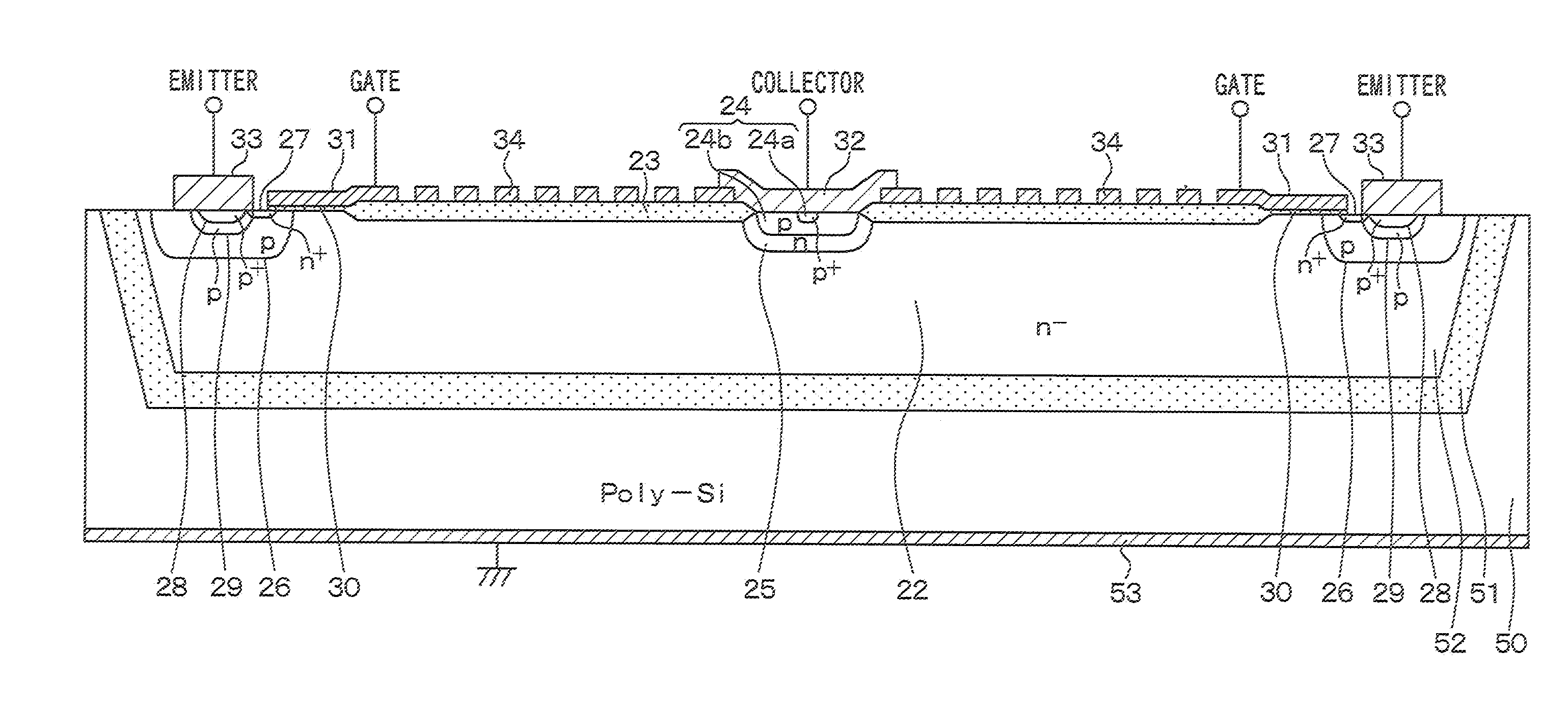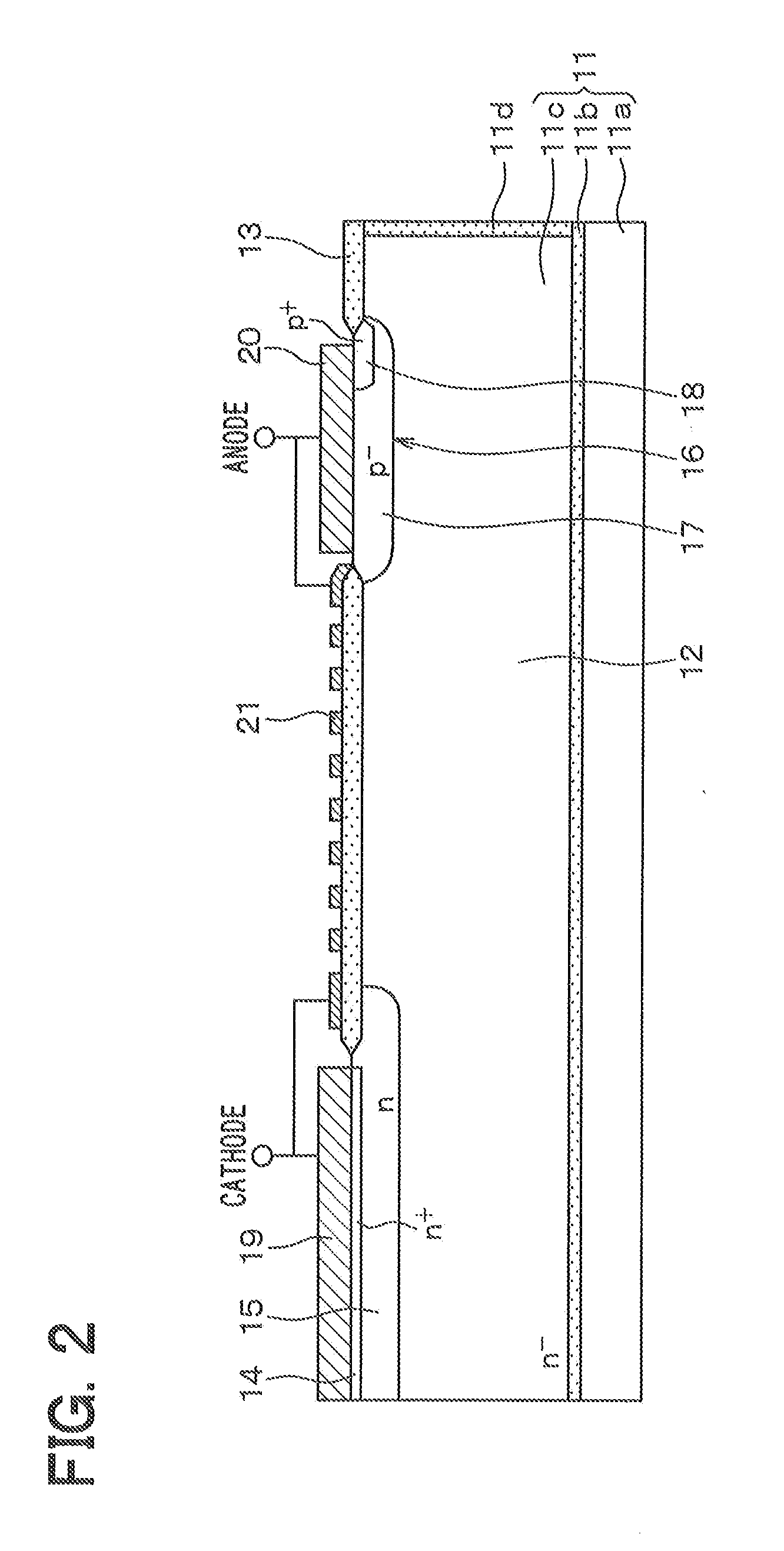Semiconductor device with lateral element
a technology of lateral element and semiconductor device, which is applied in the direction of semiconductor device, basic electric element, electrical apparatus, etc., can solve the problems of reducing the resistance value of transitional withstanding voltage, increasing the switching loss and occurrence of damage to the element, and difficult to meet the requirements of micro inverter such as high speed operation, high efficiency and low loss, so as to reduce the resistance value and reduce the damage to the lateral element. , the effect of switching loss of the lateral elemen
- Summary
- Abstract
- Description
- Claims
- Application Information
AI Technical Summary
Benefits of technology
Problems solved by technology
Method used
Image
Examples
first embodiment
[0042]A first embodiment of the present invention will be described. In the present embodiment, an inverter for driving a three-phase motor will be described as an example of a semiconductor device having a lateral element.
[0043]FIG. 1 is a circuit diagram of an inverter 1. As shown in FIG. 1, the inverter 1 is used to alternating-current drive a three-phase motor 3 as a load based on a direct-current power source 2.
[0044]The inverter 1 includes three series sections, each having an upper arm 5 and a lower arm 6 connected in series, corresponding to the three phases of the motor 3, and the three series sections are connected in parallel to each other. The inverter 1 successively applies the middle potential between the upper arm 5 and the lower arm 6 of each series section to corresponding one of a U-phase, a V-phase and a W-phase of the three-phase motor 3. Each of the upper arm 5 and the lower arm 6 has a lateral FWD 7 and a lateral IGBT 8. As the IGBTs 8 of the upper and lower ar...
second embodiment
[0110]A second embodiment of the present invention will be described hereinafter. In the present embodiment, the structure of the SRFP 21, 34 is modified from that of the first embodiment, and other structures are similar to the first embodiment. Thus, a part different from the first embodiment will be mainly described.
[0111]In the first embodiment, the resistance value of the total resistance R of the SRFP 21, 34 of the lateral element such as the lateral FWD 7 and the lateral IGBT 8 is adjusted. In such a case, it is assumed that the resistance value of the SRFP 21, 34 is constant in the longitudinal direction. Alternatively, the resistance value of the SRFP 21, 34 is not limited to be constant in the longitudinal direction, but may be varied in the longitudinal direction.
[0112]FIG. 18 is an enlarged view of a part of the SRFP 21, 34 of the lateral FWD 7 and the lateral IGBT 8 when viewed from the top, As shown in FIG. 18, the SRFP 21, 34 has portions that provides regions R1, R2 ...
third embodiment
[0116]A third embodiment of the present invention will be described. The present embodiment employs a semiconductor substrate other than the 301 substrate 1 of the first embodiment, and structures of the present embodiment other than the semiconductor substrate are similar to those of the first embodiment. Therefore, a different structure will be mainly described.
[0117]FIG. 19 is a diagram illustrating a cross-sectional structure of the n-channel lateral IGBT 8 according to the present embodiment. As shown in FIG. 19, a semiconductor substrate 40 in which an n−-type layer 42 is formed on a p−-type silicon substrate 41 is used. Further, the n−-type drift layer 22 is provided by the n−-type layer 42, and a p+-type isolation region 43 is formed to extend from the surface of the n−-type drift layer 22 to the p−-type silicon substrate 41.
[0118]The p+-type isolation region 43 is formed to surround the periphery of the lateral IGBT 8, and a junction isolation structure is provided by PN ju...
PUM
 Login to View More
Login to View More Abstract
Description
Claims
Application Information
 Login to View More
Login to View More - R&D
- Intellectual Property
- Life Sciences
- Materials
- Tech Scout
- Unparalleled Data Quality
- Higher Quality Content
- 60% Fewer Hallucinations
Browse by: Latest US Patents, China's latest patents, Technical Efficacy Thesaurus, Application Domain, Technology Topic, Popular Technical Reports.
© 2025 PatSnap. All rights reserved.Legal|Privacy policy|Modern Slavery Act Transparency Statement|Sitemap|About US| Contact US: help@patsnap.com



